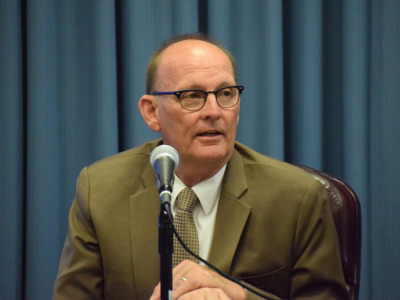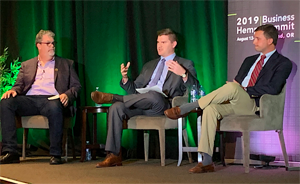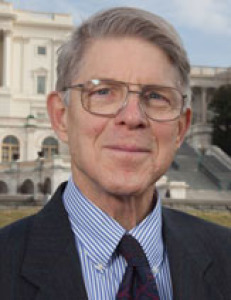Farmers should join the enthusiasm about industrial hemp’s huge potential, ranging from medicinal uses to bioplastics, chemicals, fuels, paper and bioremediation – but proceed with caution.
That was the message prospective hemp producers heard this week at the National Industrial Hemp Council Hemp Business Summit in Portland, Ore.
Greg Ibach, USDA’s undersecretary for marketing and regulatory programs, told attendees he’s “astounded by the number of uses for the fiber” from hemp, but work remains to have the crop be a commonplace commodity option for producers.
After language to legalize hemp cultivation was included in the 2018 farm bill, Ibach has worked with USDA, FDA, EPA, Treasury, USTR, Commerce and Justice Department agencies on writing rules and regulations needed for full implementation. He expects the new regulatory framework to be “in place this fall” to address issues including lab testing requirements, farm inspections, and the “destruction process” for any hemp crop that tests above the 0.3 percent THC limit.
To help farmers manage their risks with growing hemp, Ibach said USDA is focused on writing regulations that provide growers with a full range of USDA support including crop insurance and funding from USDA’s rural development programs. He also stressed that the new regulations are being published as an interim final rule to provide USDA the flexibility to work with farmers and processors on making any needed changes.

Greg Ibach, USDA
American Farm Bureau Federation lobbyist Scott Bennett congratulated the gung-ho attendees at the sold-out meeting for their interest in accelerating hemp production, processing and market development. But he said it’s also time to “pump the brakes.”
“This hemp industry has a lot of potential in the United States as an alternative for some farmers and a future for some new and emerging farmers,” he said in an interview with Agri-Pulse. But he warned that “you’re not going to become rich overnight growing hemp.”
Ibach said USDA has also identified marketing and processing issues as potential hurdles for the hemp industry, and “farmers need to be wise about looking for a contract to grow their hemp with and be careful about how they invest their money.”
A number of factors on all levels could play into a hemp producer’s success, including the language USDA is set to release in an interim final rule Bennett expects to see in the next month or so. As for individual producers, he said farmers should have a contract in line to purchase their hemp before putting a single seed in the ground and see where processing will take place.
“That will determine where growing hemp will be profitable,” he said.
Farm Bureau Economist Michael Nepveux similarly sees great potential for hemp. But he added his own cautions about serious challenges. He warned about the need to boost the farm labor supply, provide a full range of risk management tools, and develop new markets to avoid creating “a huge oversupply of hemp in the U.S.”
Vote Hemp President Eric Steenstra, a veteran hemp advocate, called for national standards to replace the hurdles posed by the patchwork of different state regulations on hemp.
Steenstra sees an urgent need for the data collection that Vote Hemp has done “because no one else was doing it.” He says hemp plantings remain unknown, but Vote Hemp has gone to every state Department of Agriculture for figures on licensing.
The results show a crop growing in popularity, but still a sliver of America’s overall crop production. In 2018, 112,000 acres were licensed for hemp production. In 2019, the number shot up to 480,000 acres, with Colorado and Oregon leading the way with 80,000 and 60,000 acres, respectively. Not all licensed acres are expected to be planted, Steenstra noted.

L to R: Steenstra, Nepveaux, and Bennett address hemp summit
While sowing four times the acreage year-over-year represents a significant jump, it still would account for only 9% of the nation’s projected 2019 acres for sorghum, the nation’s fifth-largest crop. It would be an even more minuscule half a percent of the nation’s projected corn plantings.
“We just want to see people start small” and recognize that “there’s a learning curve” for practices that include seed selection, pest management and crop rotations, Steenstra said. “I do think there are going to be a lot of farmers this year that are trying it for the first time that may not have success because they jumped into it a little too quickly.”
Food and Drug Administration Principal Associate Commissioner for Policy, Food and Drug Administration Lowell Schiller told the summit that hemp-derived cannabidiol (CBD) offers “significant public health benefits” and has sparked “an enormous amount of agricultural interest.” But he also noted that approving CBD and other uses poses potential public health risks. He said that in weighing risks and benefits, FDA is moving as rapidly as possible but needs to be cautious because there’s “too much we still don’t know about CBD” such as cumulative exposure risks and long-term effects.
Schiller called on the hemp industry itself to help provide the data needed to write rules for CBD and other hemp products. He also said that once FDA compiles the needed data, it may ask Congress for new authority to accelerate the rule-making process.
In his comments at the summit Tuesday Sen. Jeff Merkley, D-Ore., focused on another issue –financing. He called on the industry to support his new push for a legislative fix, as proposed in his proposed Secure and Fair Enforcement (SAFE) Banking Act. He said it’s past time for removing banking and other hurdles facing hemp, to spur development of “a new frontier in agriculture.”
Other speakers focused on a common theme: the more than half-century ban on growing hemp has created a shortage of the ingredients needed for rapidly turning hemp into a major U.S. crop.
National Industrial Hemp Council Board Chair Patrick Atagi sees the NIHC addressing the shortage by creating a new source of information, education, alliances and partnerships. He told Agri-Pulse the fact that this week’s hemp summit was sold out “validated that we’re on the right course, we’re providing the right information.”
With the farm sector under pressure and farmers going out of business, Atagi said “there’s a desperation out there” driving interest in hemp “where you need caution too.” He says the NIHC offers one answer: “the education we’re providing here today.”
He explained some failures with hemp have been due to “planting the wrong variety of seed in the wrong place” – a costly mistake for hemp which requires different seeds for different end products, different microclimates, different spacing and even for slight differences in elevation or planting times.
What’s most important, Atagi explains, is a long-term, market-oriented approach to advancing the hemp industry. “For the viability of hemp, we really need to be thinking of the long term.”
For more news, go to www.Agri-Pulse.com.


